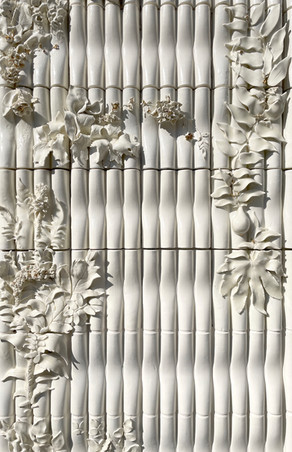UNA ROSA EN TERRITORIOS DESPLAZADOS: FROM GARDENS IN EUROPE TO FLORICOLAS IN PISQUE, ANDES
- SSAW Collective
- Feb 9, 2024
- 2 min read
Charlotte More and Claudia Robalino

Straight stem, perfect petals, no thorns, 12 hrs continuous sunlight, cold nights, extended growth cycle, Pantone colour, routine chemical infusions, Páramo water, volcanic soil, indigenous care system, no scent, muted.
Scentless. Seedless.
Inside tunnels of translucid plastic are compressed thousands of identical rose bushes. All catalogued, coded & labelled.
1.5m tall, 40cm tall, peach, lavender, cherry snow.
2500m above sea level, cyclical cosmologies & ancestral knowledge care for the land, ‘Pacha Mama,’ in human-nature symbiosis. For centuries, indigenous communities have grown potatoes & corn within this ecosystem, learning from moulding forces of active volcanoes, inhabiting thin Andean air, domesticating, protecting & digesting the environment.
Rain & wind do not touch roses here. They don’t interact with other species or experience pollination. They are not permitted to adapt, belonging always to a dislocated landscape, extracting minerals from the soil, drawing Andean water, synthesising year-round sunlight, yet all within an impenetrable plastic house.
‘House,’ in this case, is a typology of territorial realities & corporeal sensations, where local women act as nurturers. Sheltered. The extractivist system detaches the rose from the territory it occupies – no temporality, no fertility but instead dependency, absence.
As they encroach further upon indigenous territory, roses become vessels for western colonisation, amplifying the effects of climate change & the lack of communication methodologies between the Global South & North. Dislocation at high altitude. Ambivalent landscape.
The rose, once valued for its ephemeral blooms & medicinal oils, is now a commodity, an object, a production system. We have detached it from nature, its scent & ignored its societal cost.


Discover More
Claudia is an Ecuadorian practice-based researcher and architect. Her work explores conflicted ecologies through performative fieldwork, storytelling and cross-cultural collaboration. She investigates alternative systems of socio-environmental design and human-nature cohabitation by employing the right to opacity as a design methodology to resist extractive assumptions and invasive, colonialist narratives. Her practice is rooted in rituals of care where land and crops in conjunction with the role of women as nurturers and carriers of knowledge act as agents of repair and intimacy responding to our planetary crisis.
Charlotte’s childhood was spent in the Tamar Valley, Cornwall. Her deep ties to this verdant landscape inform the materiality of her work and many of her projects have been collaborative, site-specific and community-oriented in nature. Analysing human interaction with the natural world, she is passionate about exploring how successive seasonal and temporal cycles of nature recolonise landscapes and architectures expanding her practice into designing for plants and their associated lifeforms alongside our own human experience. Drawing landscape research and its wider questions of colonisation, fertility and historical practice into physical manifestations such as hand-sculpted ceramic façades, she reimagines shared spaces; reintroducing narrative, ornamentation and feminine experience where these have been shunned for so long.
Concerned with putting aside certain western assumptions on social and climate conservation, they shine a light on the exploitation of the rose and the indigenous territories that the rose farms occupy in Latin America.










Comments